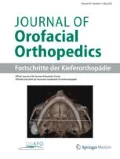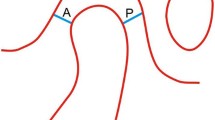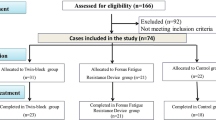Abstract
Introduction
The aim of this study was to three-dimensionally analyze the net skeletal, dental, and temporomandibular joint (TMJ) treatment changes using Twin Block functional therapy in comparison to untreated subjects.
Materials and methods
The study (Twin Block) group comprised 22 female patients with skeletal Class II malocclusion due to mandibular retrusion. A total of 18 skeletal Class II untreated female subjects were included as controls. Skeletal, dental, and TMJ changes were evaluated using pre- and posttreatment/observational by cone beam computed tomography (CBCT) images. The treatment changes were compared with the growth changes observed in the control group using independent t‑tests.
Results
Compared to the changes induced by normal growth, the effective mandibular length, ramus, and corpus lengths increased by 3.19, 3.47, and 2.69 mm (P < 0.001 for all), respectively. The maxillary and mandibular incisors inclination and position were significantly reduced and increased, respectively (P < 0.001). The maxillary first molars were significantly moved distally and intruded by 1 and 0.36 mm, respectively, while the lower first molars moved mesially and intruded by 2.18 and 0.59 mm, respectively. There was a significant change in the condylar dimensions: increase in length, width, and height by 1.28, 0.88, 1.59 on the right and by 1.60, 0.53, and 1.10 mm on the left sides, respectively. There was significant forward positioning of the right and left condyle by 1.5 and 1.3 mm, respectively.
Conclusions
Treatment with the Twin Block functional appliance results in significant skeletal, dentoalveolar, and condylar changes in both dimensions and positions.
Zusammenfassung
Einleitung
Ziel der Studie war die Untersuchung skelettaler, dentaler und temporomandibulärer Veränderungen nach einer Twin-Block-Therapie im Vergleich mit einer unbehandelten Kontrollgruppe.
Material und Methoden
Die Interventionsgruppe (Twin Block) umfasste 22 Patientinnen mit skelettaler Klasse-II-Malokklusion und Unterkieferrücklage. 18 unbehandelte Klasse-II-Patientinnen dienten als Kontrollgruppe. Skelettale, dentale und temporomandibuläre Veränderungen wurden anhand von DVT-Aufnahmen evaluiert, die vor und nach Behandlung bzw. während der Behandlung angefertigt worden waren. Mittels t‑Tests für unabhängige Stichproben wurden die behandlungs- bzw. die wachstumsbedingten Veränderungen in der Interventions- und der Kontrollgruppe miteinander verglichen.
Ergebnisse
Im Vergleich mit den Veränderungen, die sich wachstumsbedingt ergeben haben, erhöhten sich die effektive Unterkieferlänge sowie die Längen von Ramus und Corpus mandibulae um 3,19, 3,47 bzw. 2,69 mm (p < 0,001 für alle). Inklination und Position der Oberkieferinzisivi verringerten sich signifikant (p < 0,001), Inklination und Position der Unterkieferinzisivi erhöhten sich dagegen signifikant (p < 0,001). Die ersten Molaren im Oberkiefer wurden signifikant um 1,0 bzw. 0,36 mm distalisiert und intrudiert, während die unteren ersten Molaren um 2,18 bzw. 0,59 mm mesialiert und intrudiert wurden. Es gab signifikante Veränderungen an den Kondylen: Länge, Breite und Höhe vergrößerten sich um 1,28, 0,88 bzw. 1,59 auf der rechten und um 1,60, 0,53 bzw. 1,10 mm auf der linken Seite. Auf beiden Seiten kam es zu einer signifikanten Vorverlagerung der Kondylen um 1,5 (rechts) bzw. 1,3 mm (links).
Schlussfolgerungen
Die Behandlung mit einem Twin-Block-Funktionsgerät führte zu signifikanten skelettalen, dentoalveolären und temporomandibulären Veränderungen.


Similar content being viewed by others
References
Al-Saleh M, Alsufyani N, Flores-Mir C, Nebbe B, Major P (2015) Changes in temporomandibular joint morphology in class II patients treated with fixed mandibular repositioning and evaluated through 3D imaging: a systematic review. Orthod Craniofac Res 18:185–201
Alhammadi M, Fayed M, Labib A (2017) Three-dimensional assessment of condylar position and joint spaces after maxillary first premolar extraction in skeletal class II malocclusion. Orthod Craniofac Res 20:71–78
Alhammadi MS, Fayed MS, Labib A (2016) Three-dimensional assessment of temporomandibular joints in skeletal class I, class II, and class III malocclusions: cone beam computed tomography analysis. J World Fed Orthod 5:80–86
Alhammadi MS, Shafey AS, Fayed MS, Mostafa YA (2014) Temporomandibular joint measurements in normal occlusion: a three-dimensional cone beam computed tomography analysis. J World Fed Orthod 3:155–162
Baccetti T, Franchi L, Toth LR, McNamara JA (2000) Treatment timing for twin-block therapy. Am J Orthod Dentofacial Orthop 118:159–170
Bowen L, Yanmin W, Fang S, Min L, Ying D, Li Z (2013) Cone-beam CT evaluation of the changes in the temporomandibular joint of patients with class II division 1 subdivision malocclusion before and after Twin-block treatment. Hua Xi Kou Qiang Yi Xue Za Zhi 31:610–614
Chavan SJ, Bhad WA, Doshi UH (2014) Comparison of temporomandibular joint changes in twin block and bionator appliance therapy: a magnetic resonance imaging study. Prog Orthod 15:57
Clark W (2014) Twin block functional therapy. JP Medical Ltd, London
De Vos W, Casselman J, Swennen G (2009) Cone-beam computerized tomography (CBCT) imaging of the oral and maxillofacial region: a systematic review of the literature. Int J Oral Maxillofac Surg 38:609–625
Ehsani S, Nebbe B, Normando D, Lagravere MO, Flores-Mir C (2014) Short-term treatment effects produced by the twin-block appliance: a systematic review and meta-analysis. Eur J Orthod 37:170–176
Elkordy SA, Abouelezz AM, Salah Fayed MM, Attia KH, Rahman Ishaq RA, Mostafa YA (2015) Three-dimensional effects of the mini-implant—anchored forsus fatigue resistant device: a randomized controlled trial. Angle Orthod 86:292–305
Gribel BF, Gribel MN, Frazão DC, McNamara JA Jr, Manzi FR (2011) Accuracy and reliability of craniometric measurements on lateral cephalometry and 3D measurements on CBCT scans. Angle Orthod 81:26–35
Henry R (1957) A classification of class II, division I malocclusion. Angle Orthod 27:83–92
Ivorra-Carbonell L, Montiel-Company J‑M, Almerich-Silla J‑M, Paredes-Gallardo V, Bellot-Arcís C (2016) Impact of functional mandibular advancement appliances on the temporomandibular joint—a systematic review. Med Oral Patol Oral Cir Bucal 21:e565–e572
Jena AK, Duggal R, Parkash H (2005) Orthopedic and orthodontic effects of twin-block appliance. J Clin Pediatr Dent 29:225–230
Jena AK, Duggal R, Parkash H (2006) Skeletal and dentoalveolar effects of twin-block and bionator appliances in the treatment of class II malocclusion: a comparative study. Am J Orthod Dentofacial Orthop 130:594–602
LeCornu M, Cevidanes LH, Zhu H, Wu C‑D, Larson B, Nguyen T (2013) Three-dimensional treatment outcomes in class II patients treated with the Herbst appliance: a pilot study. Am J Orthod Dentofacial Orthop 144:818–830
Lund DI, Sandler PJ (1998) The effects of twin blocks: a prospective controlled study. Am J Orthod Dentofacial Orthop 113:104–110
Jr McNamara JA (1981) Components of class II malocclusion in children 8–10 years of age. Angle Orthod 51:177–202
Mills CM, McCulloch KJ (1998) Treatment effects of the twin block appliance: a cephalometric study. Am J Orthod Dentofacial Orthop 114:15–24
Mills CM, McCulloch KJ (2000) Posttreatment changes after successful correction of class II malocclusions with the twin block appliance. Am J Orthod Dentofacial Orthop 118:24–33
Morris DO, Illing HM, Lee RT (1998) A prospective evaluation of bass, Bionator and twin block appliances. Eur J Orthod 20:663–684
Moyers RE, Riolo ML, Guire KE, Wainright RL, Bookstein FL (1980) Differential diagnosis of class II malocclusions: part 1. Facial types associated with class II malocclusions. Am J Orthod 78:477–494
O’Brien K, Wright J, Conboy F, Sanjie Y, Mandall N, Chadwick S, Connolly I, Cook P, Birnie D, Hammond M (2003) Effectiveness of early orthodontic treatment with the twin-block appliance: a multicenter, randomized, controlled trial. Part 1: dental and skeletal effects. Am J Orthod Dentofacial Orthop 124:234–243
Pinheiro F (2015) Twin block functional therapy: applications in dentofacial orthopedics. Am J Orthod Dentofacial Orthop 147:636
Proffit WR, Fields H Jr, Moray L (1997) Prevalence of malocclusion and orthodontic treatment need in the United States: estimates from the NHANES III survey. Int J Adult Orthodon Orthognath Surg 13:97–106
Ruf S, Baltromejus S, Pancherz H (2001) Effective condylar growth and chin position changes in activator treatment: a cephalometric roentgenographic study. Angle Orthod 71:4–11
Saikoski LZ, Cançado RH, Valarelli FP, KMSd F (2014) Dentoskeletal effects of class II malocclusion treatment with the twin block appliance in a Brazilian sample: a prospective study. Dental Press J Orthod 19:36–45
Sharma A, Sachdev V, Singla A, Kirtaniya B (2012) Skeletal and dentoalveolar changes concurrent to use of twin block appliance in class II division I cases with a deficient mandible: a cephalometric study. J Indian Soc Pedod Prev Dent 30:218–226
Sidlauskas A (2005) The effects of the twin-block appliance treatment on the skeletal and dentolaveolar changes in class II division 1 malocclusion. Medicina (Kaunas) 41:392–400
Singh G, Hodge M (2002) Bimaxillary morphometry of patients with class II division 1 malocclusion treated with twin block appliances. Angle Orthod 72:402–409
Toth LR, McNamara JA (1999) Treatment effects produced by the twin-block appliance and the FR-2 appliance of Fränkel compared with an untreated class II sample. Am J Orthod Dentofacial Orthop 116:597–609
Trenouth M (2000) Cephalometric evaluation of the twin-block appliance in the treatment of class II division 1 malocclusion with matched normative growth data. Am J Orthod Dentofacial Orthop 117:54–59
Trenouth M (2002) Proportional changes in cephalometric distances during twin block appliance therapy. Eur J Orthod 24:485–491
Varlık SK, Gültan A, Tümer N (2008) Comparison of the effects of twin block and activator treatment on the soft tissue profile. Eur J Orthod 30:128–134
Vedavathi H, Chirag A (2016) Comparative assessment of condylar changes in patients treated with twin block appliance: a cone-beam computed tomography study. J Dent Med Sci (IOSR-JDMS) 15:1–7
Yildirim E, Karacay S, Erkan M (2014) Condylar response to functional therapy with twin-block as shown by cone-beam computed tomography. Angle Orthod 84:1018–1025
Author information
Authors and Affiliations
Corresponding author
Ethics declarations
Conflict of interest
H.Y. Elfeky, M.S. Fayed, M.S. Alhammadi, S.A.Z. Soliman and D.M. El Boghdadi declare that they have no competing interests.
Rights and permissions
About this article
Cite this article
Elfeky, H.Y., Fayed, M.S., Alhammadi, M.S. et al. Three-dimensional skeletal, dentoalveolar and temporomandibular joint changes produced by Twin Block functional appliance. J Orofac Orthop 79, 245–258 (2018). https://doi.org/10.1007/s00056-018-0137-1
Received:
Accepted:
Published:
Issue Date:
DOI: https://doi.org/10.1007/s00056-018-0137-1
Keywords
- Class II malocclusion
- Functional orthopedic appliance
- Twin Block
- Temporomandibular joint
- Cone beam computed tomography




